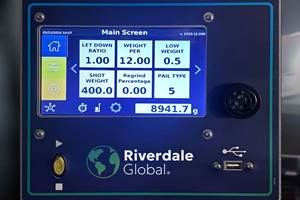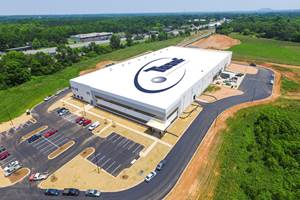Accuracy, Simplicity of Gravimetric Metering Technology Built into Economical New TrueFeed™ Feeder from Conair
New TrueFeed™ color and additive feeders from Conair employ gravimetric (loss-in-weight) metering technology to improve accuracy, while making the units simpler to operate.
New TrueFeed™ color and additive feeders from Conair employ gravimetric (loss-in-weight) metering technology to improve accuracy, while making the units simpler to operate. Unlike volumetric feeders, which have been standard in the plastics industry for years, the new Conair gravimetric feeders are self-calibrating, adjusting automatically for changes in material type, bulk density or pellet geometry. This, in turn, results in easier set-up and greater processing up-time for increased productivity. With prices starting at just $3495, the new TrueFeed units are economical too… less than 25% more than the company’s old-style volumetric BFH feeders. “Twenty years ago, gravimetric blenders accounted for fewer than 10% of all blenders sold in the plastics industry,” recalls Gary Hovis, Commercial Mgr., Blenders & Feeders. “In the last two decades, those percentages have reversed, with very few volumetric blenders being sold outside of certain niche market segments. Volumetric feeders, on the other hand, have held onto their market share for somewhat longer because gravimetric units have been quite expensive. Now that we have been able to get the TrueFeed pricing to volumetric levels, they have the potential to take over the feeder market the way gravimetric blenders came to dominate the blender market in the late 1980s and through the 1990s.” The new TrueFeed gravimetric feeder uses a rotating tube to meter material more consistently and more accurately than the flighted auger used in most volumetric units. The metering tube is driven by a microprocessor controlled stepper motor, which starts and stops more precisely than the conventional DC motors that are common in volumetric feeders. However, the accuracy of the TrueFeed really arises from the fact that the ingredient hopper is weighed continuously. As material is dispensed, the weight loss is registered and the feeder runs until the exact amount has been delivered to the machine feedthroat. Then it stops. If material characteristics (bulk density, particle geometry, etc.) change, the speed of the metering unit is adjusted automatically to compensate. The digital weighing unit is accurate even under high-vibration conditions. With volumetric feeders, on the other hand, users are required to collect and weigh as many as a dozen material samples to determine how long the auger must turn to dispense a given weight. If the character of the material changes, the time-consuming calibration process must be repeated. Even with proper calibration, volumetric units are notoriously inaccurate and processors have traditionally compensated by using more additives or colorants than are really needed. Sometimes these ingredients can cost up to $50/lb or more, so using even a small amount more than necessary can be quite expensive. With the digital precision of the TrueFeed, processors can be assured they are getting just the right amount of color or additive. And in many cases they find they can get by with a lower setting since it is being dispensed so precisely. The basic TrueFeed unit is sized to feed as little as 0.02g/sec (0.07 kg/hr) or as much as 20g/sec (72 kg/hr). For higher throughput requirements, a unit with a larger stepper motor can be supplied to feed as much as 50g/sec (180 kg/hr). The feeder can be ordered with a standard hand-fill hopper or with an integral compressed-air loader. The loader, when supplied, is controlled through the standard microprocessor control that comes with the TrueFeed. The control itself is easy to use. The operator sets the color or additive percentage, enters the part weight and cycle time, and presses the start button. After initial calibration, no calibration is required for accurate, consistent metering. These operating parameters can be stored in memory for easy recall the next time the same job/material is run. The system can store up to 1500 set-ups. A standard communications package is available to deliver material usage data to a central host computer for inventory control or process documentation. When using two feeders on the same molding machine or extruder, this communication port can be used to tie the two units together for improved product quality. For more information, call the New Product Hotline at 1-888-486-6601
Related Content
How to Optimize Color Evaluation of Recycled Plastics
The right color measurement instrument and good working methods will minimize variability in color evaluation of PCR.
Read MoreRiverdale Global Showing Latest Innovations and New Satellite Location in Wisconsin
NPE2024: Live demos of updated RGS controller are among the highlights at its Wisconsin facility that will house the ‘new’ color R&D lab.
Read MoreTosaf’s Investments in North America Result in 40% Increase in Production Capacity
Backed by a global presence, Tosaf provides localized additive and color solutions, and services for the plastic industry in North America.
Read MoreChroma Color Expands Footprint With Acquisition of Spectra Color
Specialty color and additives supplier acquires manufacturer of colorants and precolored resin compounds.
Read MoreRead Next
Beyond Prototypes: 8 Ways the Plastics Industry Is Using 3D Printing
Plastics processors are finding applications for 3D printing around the plant and across the supply chain. Here are 8 examples to look for at NPE2024.
Read MoreLead the Conversation, Change the Conversation
Coverage of single-use plastics can be both misleading and demoralizing. Here are 10 tips for changing the perception of the plastics industry at your company and in your community.
Read MoreMaking the Circular Economy a Reality
Driven by brand owner demands and new worldwide legislation, the entire supply chain is working toward the shift to circularity, with some evidence the circular economy has already begun.
Read More








